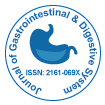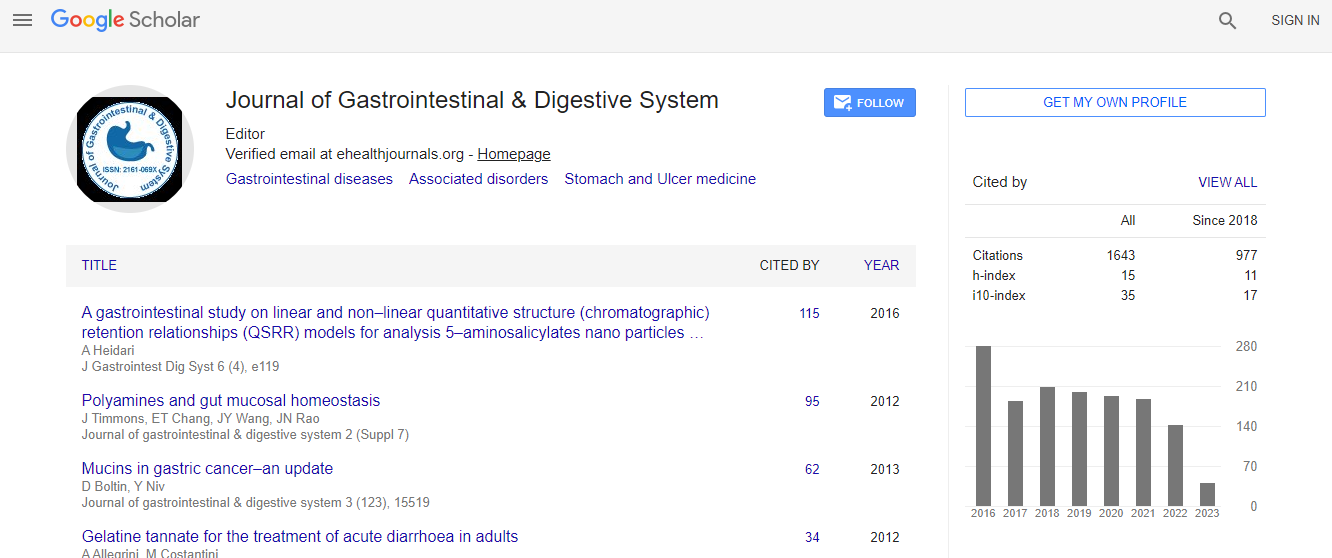Our Group organises 3000+ Global Conferenceseries Events every year across USA, Europe & Asia with support from 1000 more scientific Societies and Publishes 700+ Open Access Journals which contains over 50000 eminent personalities, reputed scientists as editorial board members.
Open Access Journals gaining more Readers and Citations
700 Journals and 15,000,000 Readers Each Journal is getting 25,000+ Readers
Google Scholar citation report
Citations : 2091
Journal of Gastrointestinal & Digestive System received 2091 citations as per Google Scholar report
Journal of Gastrointestinal & Digestive System peer review process verified at publons
Indexed In
- Index Copernicus
- Google Scholar
- Sherpa Romeo
- Open J Gate
- Genamics JournalSeek
- China National Knowledge Infrastructure (CNKI)
- Electronic Journals Library
- RefSeek
- Hamdard University
- EBSCO A-Z
- OCLC- WorldCat
- SWB online catalog
- Virtual Library of Biology (vifabio)
- Publons
- Geneva Foundation for Medical Education and Research
- Euro Pub
- ICMJE
Useful Links
Recommended Journals
Related Subjects
Share This Page
Standardization of an isolation protocol of group a rotaviruses among neonatal diarrheic calves, Morocco
9th Euro Global Gastroenterology Conference
Ennima Imane, Sebbar Ghizlane, Harif Bachir, Amzazi Saaid, Loutfi Chafiqa and Touil Nadia
University Mohammed V, Morocco Soci√?¬©t√?¬© de Productions des Produits Biologiques and V√?¬©t√?¬©rinaires, Morocco
Posters & Accepted Abstracts: J Gastrointest Dig Syst
Abstract
Group A rotaviruses (RVA) are the main cause of neonatal calve diarrhea (NCD) in Morocco. Until now, no reports are available regarding isolation and cultivation of RVA in clinical samples from Moroccan domestic animals or children with acute gastroenteritis (AGE) and burden due to this infection in animals remain unknown. Hence, this study aims to isolate RVA strains from NCD clinical samples in order to support RVA disease control in Morocco. This isolation process constitutes a first step toward vaccine development. Thirteen fecal samples were obtained from calves with a single episode of neonate calf diarrhea at three different dairies and two samples were collected from field during a severe NCD outbreak. Diagnosis of RVA infection was based on fecal immune-chromatographic rapid test and further evaluated for their hemagglutination (HA) activity. RVA isolation was carried out on MA104 cells after inoculates were treated with different concentrations of trypsin TPCK. All RVA isolates were confirmed by LSI VetMAX√ʬ?¬Ę Triplex Ruminant Rotavirus and Coronavirus Real-Time PCR kit. RVA isolation was achieved for nine clinical samples following one or two passages (60%) and was properly depended on HA activity and trypsin treatment of inoculates. The first sign of CPE detected consisted of increased cell granularity, obscure cell boundaries, cell rounding, and eventual degeneration and detachment of cells. These results constitute a crucial and a necessary step allowing preventive and veterinary medicine to support RVA disease controls in the country.Biography
Email: ennima.imane@gmail.com

 Spanish
Spanish  Chinese
Chinese  Russian
Russian  German
German  French
French  Japanese
Japanese  Portuguese
Portuguese  Hindi
Hindi 
